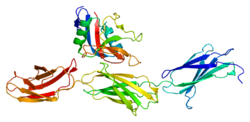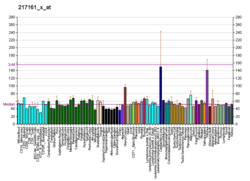
Back ACAN Welsh Aggrecan German Agrecano Spanish اگریکان Persian Agrécane French Aggrekán Hungarian Aggrecano Italian Аггрекан Russian ACAN Ukrainian
Aggrecan (ACAN), also known as cartilage-specific proteoglycan core protein (CSPCP) or chondroitin sulfate proteoglycan 1, is a protein that in humans is encoded by the ACAN gene.[5] This gene is a member of the lectican (chondroitin sulfate proteoglycan) family. The encoded protein is an integral part of the extracellular matrix in cartilagenous tissue and it withstands compression in cartilage.
Aggrecan is a proteoglycan, or a protein modified with large carbohydrates; the human form of the protein is 2316 amino acids long and can be expressed in multiple isoforms due to alternative splicing.[5] Aggrecan was named for its ability to form large aggregates in the cartilage tissue (a large aggregating proteoglycan).[6] [7]
- ^ a b c GRCh38: Ensembl release 89: ENSG00000157766 – Ensembl, May 2017
- ^ a b c GRCm38: Ensembl release 89: ENSMUSG00000030607 – Ensembl, May 2017
- ^ "Human PubMed Reference:". National Center for Biotechnology Information, U.S. National Library of Medicine.
- ^ "Mouse PubMed Reference:". National Center for Biotechnology Information, U.S. National Library of Medicine.
- ^ a b Doege KJ, Sasaki M, Kimura T, Yamada Y (January 1991). "Complete coding sequence and deduced primary structure of the human cartilage large aggregating proteoglycan, aggrecan. Human-specific repeats, and additional alternatively spliced forms". J. Biol. Chem. 266 (2): 894–902. doi:10.1016/S0021-9258(17)35257-2. PMID 1985970.
- ^ Aspberg A (December 2012). "The different roles of aggrecan interaction domains". The Journal of Histochemistry and Cytochemistry. 60 (12): 987–96. doi:10.1369/0022155412464376. PMC 3527881. PMID 23019016.
- ^ Chremos A, Horkay F (September 2023). "Coexistence of Crumpling and Flat Sheet Conformations in Two-Dimensional Polymer Networks: An Understanding of Aggrecan Self-Assembly". Physical Review Letters. 131 (13): 138101. Bibcode:2023PhRvL.131m8101C. doi:10.1103/PhysRevLett.131.138101. PMID 37832020. S2CID 263252529.







